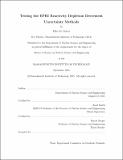| dc.contributor.advisor | Kord Smith. | en_US |
| dc.contributor.author | Sykora, Elliot M | en_US |
| dc.contributor.other | Massachusetts Institute of Technology. Department of Nuclear Science and Engineering. | en_US |
| dc.date.accessioned | 2016-07-18T19:10:13Z | |
| dc.date.available | 2016-07-18T19:10:13Z | |
| dc.date.copyright | 2015 | en_US |
| dc.date.issued | 2015 | en_US |
| dc.identifier.uri | http://hdl.handle.net/1721.1/103653 | |
| dc.description | Thesis: S.M., Massachusetts Institute of Technology, Department of Nuclear Science and Engineering, 2015. | en_US |
| dc.description | This electronic version was submitted by the student author. The certified thesis is available in the Institute Archives and Special Collections. | en_US |
| dc.description | Cataloged from student-submitted PDF version of thesis. | en_US |
| dc.description | Includes bibliographical references (page 88). | en_US |
| dc.description.abstract | An EPRI study[1], published in 2011, used measured flux map data (taken over 44 operational cycles of the Catawba and McGuire nuclear power plants) to determine fuel assembly reactivity decrements versus burnup. The analytical techniques used to infer measured assembly reactivities required perturbation calculations using 3D nodal diffusion core models. Subsequently, questions have arisen within the Nuclear Regulatory Commission (NRC) as to potential uncertainties in measured assembly reactivity decrements that might have arisen from approximations of the 2-group nodal methods and perturbation techniques employed. Subsequently, Gunow[2] used full-core, multi-group, neutron transport models to replace the nodal diffusion core models, and he demonstrated that measured reactivity decrements were independent of the core model. In this thesis, two cycles of the BEAVRS PWR reactor benchmark are used to test the EPRI methodology, now including testing of not only the nodal core diffusion model, but also the perturbation technique itself. By changing the perturbation technique from assembly reactivity to assembly-average fuel temperature, it is demonstrated that measured reactivity decrements are almost independent of the perturbation technique - with a level of precision greater then the 250 pcm reactivity decrement uncertainty assigned in the EPRI study. These new results demonstrate that the reactivity decrements and uncertainties derived by nodal diffusion and burnup perturbation in the original EPRI study hold up to further scrutiny, and they remain credible for licensing application of burnup credit in Spent Fuel Pool (SFP) criticality analysis. | en_US |
| dc.description.statementofresponsibility | by Elliot M. Sykora. | en_US |
| dc.format.extent | 128 pages | en_US |
| dc.language.iso | eng | en_US |
| dc.publisher | Massachusetts Institute of Technology | en_US |
| dc.rights | M.I.T. theses are protected by copyright. They may be viewed from this source for any purpose, but reproduction or distribution in any format is prohibited without written permission. See provided URL for inquiries about permission. | en_US |
| dc.rights.uri | http://dspace.mit.edu/handle/1721.1/7582 | en_US |
| dc.subject | Nuclear Science and Engineering. | en_US |
| dc.title | Testing the EPRI reactivity depletion decrement uncertainty methods | en_US |
| dc.title.alternative | Testing the Electric Power Research Institute reactivity depletion decrement uncertainty methods | en_US |
| dc.type | Thesis | en_US |
| dc.description.degree | S.M. | en_US |
| dc.contributor.department | Massachusetts Institute of Technology. Department of Nuclear Science and Engineering | |
| dc.identifier.oclc | 953277565 | en_US |
